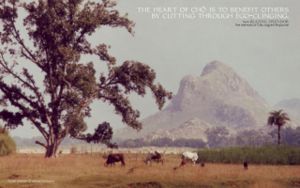Charnel ground

Charnel ground (Skt. śmāśāna; Tib. དུར་ཁྲོད་, durtrö; Wyl. dur khrod) — on the ordinary level, the charnel ground is simply a place where bodies are disposed of, either by cremation or burial. From a spiritual point of view however, the charnel ground is full of significance. It represents the death of ego, and the end of:
- attachment to this body and life
- craving for a body and life in the future
- fear of death
- and aversion to the decay of impermanence.
They are terrifying places, full of roaming spirits and hunting ghosts. There are bodies everywhere: fresh bodies, decaying bodies, skeletons and scattered bones. There are rivers of blood, poisonous waterfalls, and dangerous wild beasts. But they are also peaceful places of solitude. There are pleasant groves, wild flowers and fruit, song-birds, tame lions and tigers, and the vast open sky above. There are no conventions to conform to and no distractions to be seduced by. Dakas and dakinis gather there to celebrate ceremonial tsok "feasts" (Skt. ganachakra). The roar of Dharma discourses resound, and the light of the inner joy of bliss radiates.[1]
- Right now, our minds are very fickle. Sometimes you like a certain place, and it inspires, and yet with that same place, if you stay too long, it bores you. […] As you practise more and more, one day this kind of habit, this fickle mind will just go. Then you will search for the bindu interpretation of the right place, and according to the classic tantric texts, that is usually what they call the “eight great charnel grounds”. So then, you have to go to a cemetery, especially to one of the eight cemeteries. There, under a tree, in the charnel ground, wearing a tiger skin skirt, holding a kapala and having this indifference between relatives and enemies, indifference between food and shit, you will practise. Then your bindu will flow. At that time, you will know how to have intercourse between emptiness and appearance.[2]
In the life in which a pratyekabuddha attains the fruit of their path, they are naturally drawn to charnel grounds. When reflecting on the bones found there, they ask "Where do these bones come from?" This awakens their many lifetimes of investigation into the twelve links of dependent origination. These twelve links then unfold in their understanding, in forward and reverse order, and on the basis of that they gain realisation.
Notes
- ↑ Source for first two paragraphs: Tulku Thondup, Masters of Miracles and Meditation, note 72, pages 366-367.
- ↑ Dzongsar Khyentse Rinpoche, from Longchen Nyingtik Practice Manual, page 66.